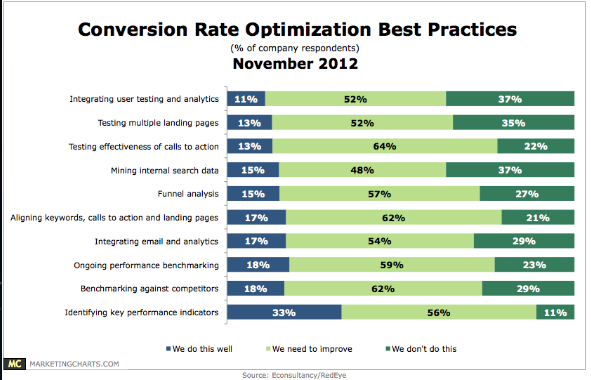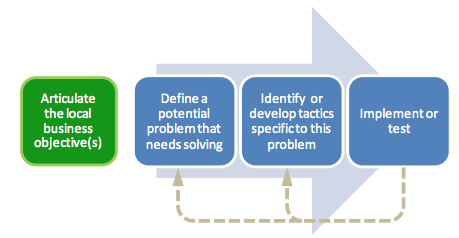
The conversion rate optimization best practices chart from Econsultancy’s “Conversion Rate Optimization Rate Report 2012″ indicate that about two-thirds of companies say their online conversion rates have improved over the past year.
Now remember this is during a recession. Now perhaps more people are turning online for better deals and taking some of the off line sales away buy still, only about 1 in 5 say they’re satisfied with those rates, while roughly twice that proportion say they’re dissatisfied.
The data shows, there is a lot of room for improvement in some of the basic core conversion optimization tactics like:
- Testing calls to action – 64% say they need to improve
- Testing multiple landing pages – 52% say they need to improve
with only identifying key performance indicators being the highest area where respondents answered – they do this well.
The image below outlines the basic process of how to use key performance indicators when it comes to optimizing conversion rates.

This is usually the first step toward aligning goals and testing. If you don’t know how or have a clear picture of how you are going to measure success you’ll never know if you’ve improved. And if you can’t show improvement higher up the org char, your optimization efforts will be short lived.
Companies ail need to step up their conversion testing rather quickly to keep the optimization department in business. Yet some of the more advanced conversion optimization tactics also have a ways to go:
- Funnel analysis – 57% say they need to improve
- Integrating user testing and analytics -52% say they need to improve
About the Data: This is Econsultancy’s fourth Conversion Rate Optimization Report carried out in association with RedEye. There were almost 900 respondents to the research request, which took the form of an online survey in July and August 2012. Respondents included both client-side (in-house) organizations who want to improve their conversion rates (59%), and agencies, vendors or consultancies (supply-side) who are involved in trying to improve conversion rates for their clients (41%). This article covers responses from the client-side only.